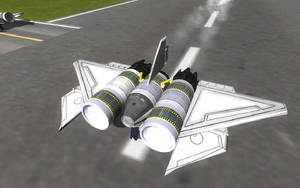Single-stage-to-orbit
Single Stage to Orbit also known as a SSTO is any vehicle that can reach orbit without having to rely on multiple stages or jettisoning components. A typical SSTO takes off from a runway or launchpad and reaches orbit with only the fuel stored within the tanks of the vehicle. SSTOs are not exclusively required to break orbit and re-enter the atmosphere for a landing as they may be refueled in orbit. Single Stage to Orbit craft generally require a firm grasp of space vehicle as well as aircraft design in order to create a vehicle that can operate both within an atmosphere and outside of an atmosphere without changing aerodynamic profile and size.
Contents
History
- It wasn't until C7 released his spaceplane pack did spaceplanes truly become integrated into Kerbal Space Program. (Needs Version when mod was created)
- Space planes were officially included in Kerbal Space Program following version 0.15.
Approaches to SSTO
An SSTOs are constructed out of various engines like their siblings the multi-stage rockets, however many issues must be considered when it comes to constructing a spaceplane.
There are 2 known types of SSTOs that are being created. There is the single stage to orbit spaceplane which takes off horizontally from a runway and lands horizontally. There is also a single stage rocket that takes off vertically and lands vertically
Solid fuel rockets are typically multi-stage, however there are many single stage rockets out there that take off vertically and land vertically with or without the assistance of parachutes.
When it comes to choosing engines for SSTOs there are two primary things that need to be addressed, power to weight ratio and efficiency.
Solid fuel rockets SSTOs are less than ideal since the thrust can not be controlled or vectored in any meaningful way and is unable to use fuel located on other parts of the spacecraft.
Air breathing engines athough useless in space are quite popular launch engines for SSTOs due to their extreme fuel efficiency which allows the SSTO to conserve precious rocket fuel until an altitude where air breathing engines are no longer effective.
Liquid fuel rockets are ideal for SSTOs due to the ability to control thrust levels as well as the ability to thrust vector. Many SSTOs use aerospike engines due to their excellent power to weight ratio and efficiency. The inability to attach separate stages onto aerospike engines has no affect on SSTO design.
Liquid air cycle engines are not present in KSP 0.16, check back later.
Whether rocket-powered or air-breathing, a reusable vehicle must be rugged enough to survive multiple round trips into space without adding excessive weight or maintenance. In addition a reusable vehicle must be able to reenter without damage, and land safely.
Issues to consider while constructing an SSTO
Spaceplane construction is far more involved and complex than rocket design. Whereas rocket design only needs to concern it with structural stability, center of gravity, and center of thrust, spaceplanes also need to be concerned with center of lift, angle of attack, as well as aerodynamic drag due to the non-symetrical vertical nature of aircraft.
Features of SSTO
A fully reusable SSTO has the benefits of lower operating costs, safer re-entry, and the ability to operate like a regular aircraft within the atmosphere.
- Can be more efficient at reaching orbit than multi-stage rockets. (Citations needed)
- Does not jettison expensive engines and structure.
- prevents having to recover and refurbish jettisoned components.
- Can operate like an aircraft within the atmosphere.
Disadvantages of SSTO
- Spaceplane type SSTOs be as heavy as a vertical rocket due to structural limitations.
- Spaceplane SSTOs require a better understanding of aerodynamics.
- Is very fuel inefficient for carrying heavy loads into orbit.
- Typically does not carry enough fuel for inter-planetary travel.
- Harder to design than multi-stage rockets.
